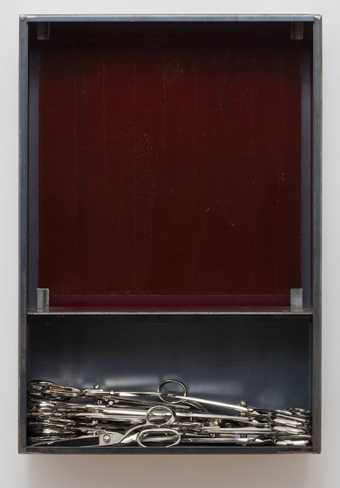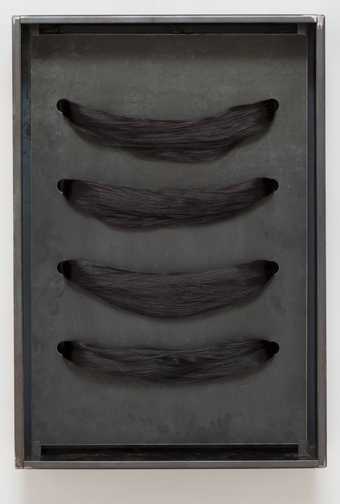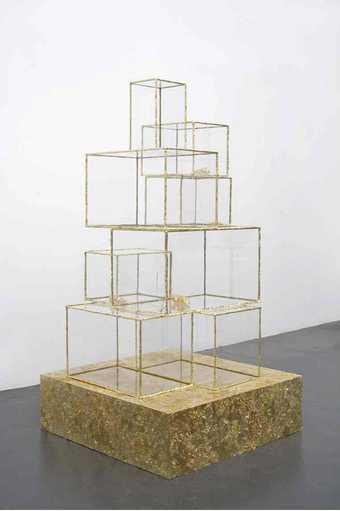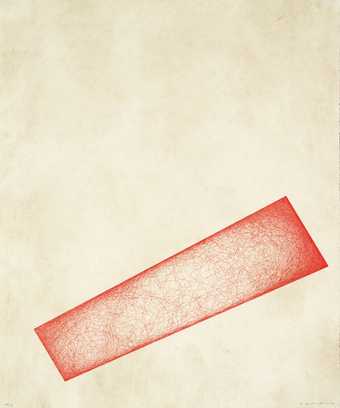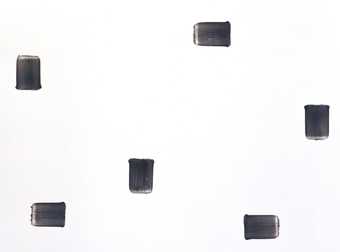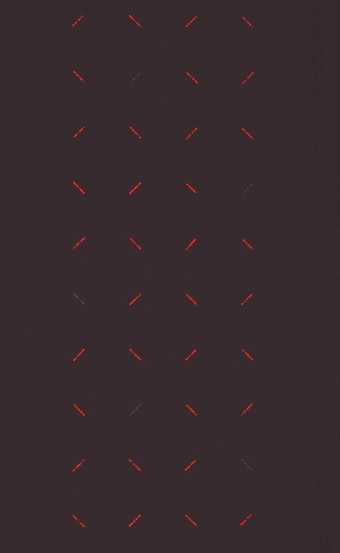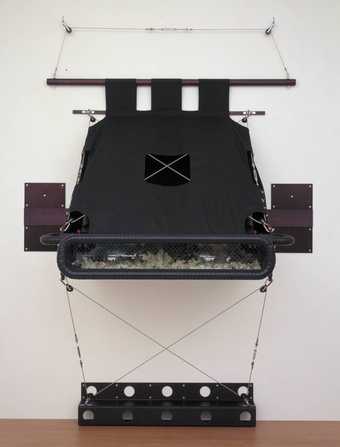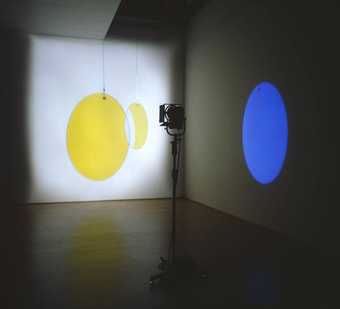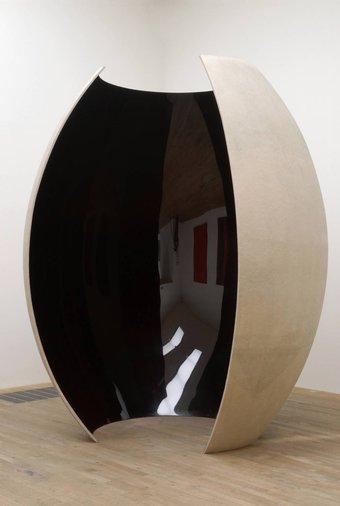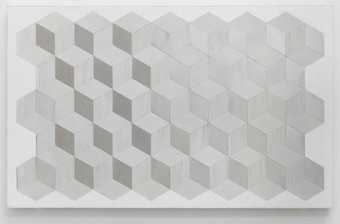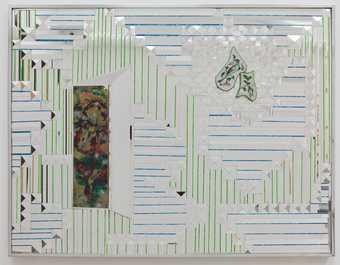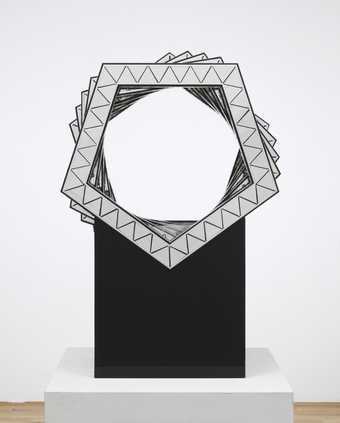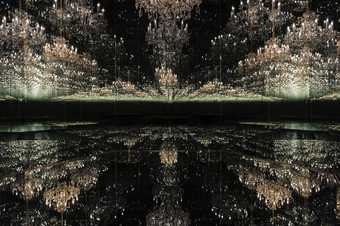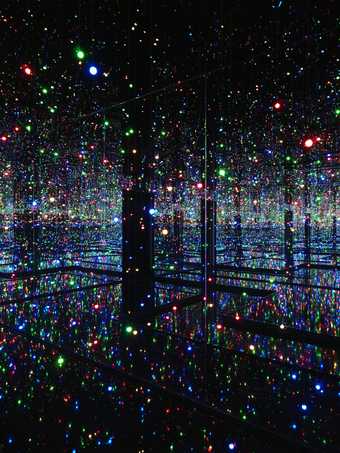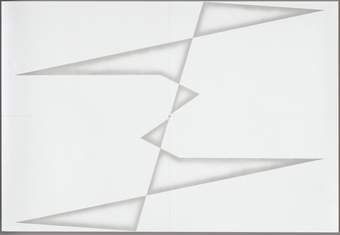
On loan
Auckland Art Gallery (Auckland, New Zealand): Light
- Artist
- Yayoi Kusama born 1929
- Medium
- Mirror and glass
- Dimensions
- Object: 1800 × 805 × 805 mm
- Collection
- Tate
- Acquisition
- Purchased with funds provided by the Asia-Pacific Acquisitions Committee 2008
- Reference
- T12821
Summary
The Passing Winter 2005 is a sculpture comprising a cube positioned on two thick panes of glass, which are arranged to form an x-shaped pedestal. The cube, which is also made of glass, has an interior and exterior lined with mirrors, and its sides each contain three circular holes of different sizes arranged in varying compositions. Viewers are invited to look through these holes to the inside of the box and in doing so can see the circular shapes that are cut into the cube’s walls reflected infinitely across its mirror-lined interior. This gives the impression of an indefinite, ever-receding space in which the reflected circles seem to float. The spectator might also see reflections of other viewers peering in through holes in the box’s other sides. The cube’s mirrored surfaces cause its appearance to alter with varying environmental conditions: the reflected dots inside the box take on different colours depending on the colour of the surrounding room, and the reflections alter in brightness depending on light conditions.
This work was made by the Japanese artist Yayoi Kusama in 2005, while the artist was living and working in Tokyo, Japan. The box is made from six panels that are secured together, yet the box itself is not fixed to the plinth, but simply rests on it. As a result, this extremely fragile sculpture must be handled and approached very carefully, and it requires regular polishing to maintain a clean, highly reflective surface. Kusama produced another version of the sculpture in the same year, which is identical to the one owned by Tate and has the same title (collection of the Walker Art Centre, Minneapolis).
The title of the sculpture is poetic-sounding and somewhat ambiguous. The phrase ‘the passing winter’ could be understood as a reference to the often snow-like appearance of the floating dots that occurs when the piece is placed in a pale room or when light catches the mirrors’ surfaces in a way that produces flashes of white. Furthermore, the notion of a passing season could reflect the transient nature of the artwork itself, which, despite being a solid object, takes on new and constantly shifting appearances as a result of variables including the time of day, the position of the viewer and the room in which it is exhibited.
Polka dots, such as the reflected circles that appear inside The Passing Winter, are a very common motif in Kusama’s practice. Since the 1950s she has used them in many works across different media, including paintings, prints, drawings, performances and installations, and several of these have involved her arranging them into large, abstract compositions, as is seen in The Passing Winter. Throughout her career Kusama has cited various reasons for her repeated use of the polka dot motif, but her most frequent explanation is that the dots have a kind of cosmological significance for her. In 1965 she said: ‘Our earth is only one polka dot among a million stars in the cosmos. Polka dots are a way to infinity. When we obliterate nature and our bodies with polka dots, we become part of the unity of our environment’ (Kusama in Jud Yalkut, ‘Polka Dot Way of Life (Conversations with Yayoi Kusama)’, New York Free Press, vol.1, no.8, 15 February 1965, p.9). This statement resonates with works such as The Passing Winter, which includes dots hovering in a void-like environment, conjuring associations with stars and planets in outer space and placing the viewer among them.
The Passing Winter is one of many works that Kusama has made since 1965 in which she used multiple mirrors to produce an infinite series of reflections. This could be connected to the fact that from an early age Kusama has suffered from a serious psychological condition which, according to her, can make her feel as if she has ‘returned to infinity, to eternal time and absolute space’ (Yayoi Kusama, InfinityNet: The Autobiography of Yayoi Kusama, London 2011, p.69) or as if she is ‘dissolving and accumulating, proliferating and separating’ (quoted in Laura Hoptman, ‘Yayoi Kusama: A Reckoning’, in Yayoi Kusama, London 2000, p.37). Kusama has frequently acknowledged that she depicts her mental states through her art as a form of ‘self-therapy’, and the disorienting appearance of mirror works such as The Passing Winter may therefore be an invitation for viewers to share in these states by experiencing their effects visually (Kusama in Akira Tatehata, ‘Akira Tatehata in Conversation with Yayoi Kusama’, in Yayoi Kusama, London 2000, p.14).
Further reading
Yayoi Kusama, exhibition catalogue, Victoria Miro Gallery, London 2008, p.6, another version of the work is reproduced pp.47–9.
Yayoi Kusama, exhibition catalogue, Padiglione d’Arte Contemporanea, Milan 2009, another version of the work is reproduced p.81.
Yayoi Kusama, exhibition catalogue, Tate Modern, London 2012.
David Hodge
October 2014
Supported by Christie’s.
Does this text contain inaccurate information or language that you feel we should improve or change? We would like to hear from you.
Display caption
Looking into this cube, you see an interior lined with mirrors to create the illusion that the circles cut into its walls are receding into infinite space. The appearance of the interior is affected by external conditions, such as the brightness of the room it is in, and any surrounding colours which can be caught by the mirrors. The title may refer to the snow-like appearance of the floating dots, or suggest the transient, ever-shifting nature of the artwork itself.
Gallery label, October 2016
Does this text contain inaccurate information or language that you feel we should improve or change? We would like to hear from you.
Film and audio
Features
Explore
- abstraction(8,615)
-
- non-representational(6,161)
-
- geometric(3,072)
You might like
-
Jannis Kounellis Untitled (Scissors)
2004 -
Jannis Kounellis Untitled (Hair)
2004 -
Terence Koh Untitled (A New World Order Lies in this Golden Age)
2006 -
Yukinori Yanagi [title not known]
1997 -
Lee Ufan Correspondence
1993 -
Tatsuo Miyajima Lattice B
1990 -
Ashley Bickerton Biofragment #2
1990 -
Olafur Eliasson Yellow versus Purple
2003 -
Sir Anish Kapoor CBE RA Ishi’s Light
2003 -
Monir Shahroudy Farmanfarmaian Untitled
1976 -
Monir Shahroudy Farmanfarmaian Something Old Something New
1974 -
Monir Shahroudy Farmanfarmaian Pentagon
2008 -
Yayoi Kusama Chandelier of Grief
2016/2018 -
Yayoi Kusama Infinity Mirrored Room - Filled with the Brilliance of Life
2011/2017 -
Goshka Macuga Drawing no.4 ‘Path of Movement of a Point’ after K. Malevich (1922)
2003

